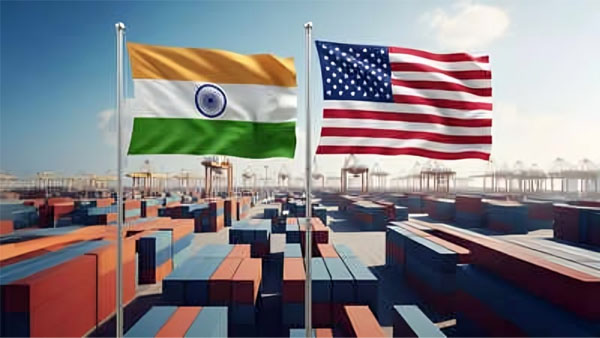India’s Test in Trump’s New Economic Order
By Dipak Kurmi
In the unfolding drama of 21st-century geopolitics, the return of Donald Trump has ignited a profound recalibration of the global economic order, compelling nations to either adapt or be swept aside. Nowhere is this reckoning more urgent than in India, where diplomatic agility and economic reform must converge to meet the tremors of a radically altered trade landscape.
Trump’s resurrection as the architect of a hard-nosed, transactional global economy has dissolved illusions of multilateral continuity. His return is not merely a political phenomenon but a declaration of economic intent: to dismantle the post-war free trade consensus, challenge the orthodoxy of globalization, and restore American primacy through strategic tariffs, bilateralism, and industrial nationalism. While traditional economists once mocked this model as unworkable, its results are difficult to ignore. Since April 2—dubbed “Liberation Day” by his allies—Trump has weaponised tariffs to not only extract trade concessions but to redefine international alignments. Within four months, the US had bent much of the global economy to its will, with only Canada and China holding out.
India, though among the first to enter talks, failed to close a deal before the August 1 deadline. The February 13 meeting between Trump and Prime Minister Narendra Modi had resulted in ambitious promises to expand bilateral trade to \$500 billion. However, Delhi’s offer did not satisfy Trump’s administration. As Brazil, Japan, South Korea, and even the EU made strategic concessions to avoid US tariffs, India found itself isolated—grouped with nations like Burma and Switzerland, facing penalties rather than privileges. This failure reflects a deeper problem: a chronic mismatch between India’s defensive negotiating style and Trump’s maximalist, coercive agenda.
Senior US officials—Scott Bessent and Senator Marco Rubio included—publicly expressed frustration with India’s position, echoing long-standing American criticisms of India’s opaque non-tariff barriers. Trump himself was particularly irritated by what he termed India’s “obnoxious” protectionist posture. This discontent is not new. Robert Lighthizer, Trump’s former trade envoy, reveals in *No Trade is Free* that Indian industry barons—not bureaucrats—were the chief stumbling blocks to reform. Labeling them “oligarchs,” Lighthizer maintained dossiers on Indian tycoons to map Delhi’s resistance to liberalization. These observations suggest India’s failure was not just diplomatic—it was systemic, rooted in the political economy of protectionism.
Meanwhile, Trump’s strategy has taken on a grander scope. Guided by economic adviser Stephen Miran, the administration has adopted a doctrine of “strategic pluralism”—forging one-on-one deals that serve US leverage rather than universal rules. Scott Bessent’s earlier writings go further, arguing that tariffs can coerce countries not just on trade, but energy policy, currency behavior, and even geopolitical alignments. Trump’s threat to sanction Indian and Chinese oil imports from Russia and his use of tariffs to undermine Brazilian President Lula in favor of Bolsonaro exemplify this fusion of economic and geopolitical tools.
In practice, three pillars support this approach: narrowing deficits, reindustrializing America, and forcing partners to buy US goods and energy. The list of concessions secured is revealing—Pakistan promising oil access, Japan and South Korea pledging investments, and Europe conceding on tariffs. Whether these deals yield long-term gains is uncertain, but Trump has already secured the political optics of triumph. India’s caution, by contrast, has produced marginalisation.
Worse still, trade is only one front. Trump’s administration is now targeting the foundational institutions of the global economy. Its backing of stablecoins and cryptocurrencies aims to entrench the dollar’s dominance in digital finance, while deregulating artificial intelligence to ensure US supremacy in next-gen technologies. At a Pittsburgh summit, Trump outlined plans to channel tariff revenues into AI-driven industrial policy. This is not the old capitalism of outsourcing and deregulation—it is an aggressive, techno-nationalist revival of American manufacturing. His economic vision pivots on reshoring supply chains and fusing strategic state intervention with private innovation.
India, still hesitant in liberalising its economy, risks falling behind in this great reset. Hemmed in by legacy institutions, bureaucratic inertia, and cronyism, it must now confront uncomfortable truths. The world Trump is forging is hostile to fence-sitters and status quo powers. A passive, reactive strategy will only deepen India’s vulnerability—not just to US pressure but to the broader costs of technological and industrial stagnation.
India’s response cannot be to appease or retreat, but to reform. It must dismantle archaic regulatory walls, unlock market competition, scale up digital and AI investments, and abandon its ambivalence toward global integration. What’s needed is not just a trade agreement with Washington, but a wholesale reorientation of economic policy. Liberalisation must be viewed not as capitulation but as self-empowerment. For India to shape its destiny in the coming decades, it must be an active architect—not a reluctant observer—of the new order.
As New Delhi resumes trade talks later this month, it must recognise this moment as historic. It is no longer enough to chase deferred deals or issue perfunctory promises. Trump’s vision—controversial as it may be—has already changed the rules. And India must decide: will it remain tethered to a vanishing world, or rise to meet the challenges of the one that is taking its place?
(the writer can be reached at dipakkurmiglpltd@gmail.com)




